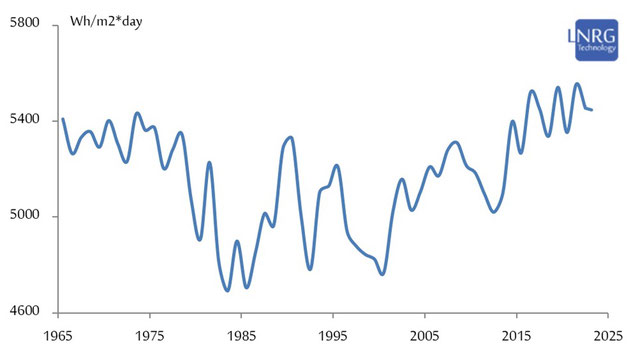
This study summarizes the 2022 ground level solar irradiance figures in the Eastern Mediterranean and makes a preliminary estimate for 2023. Regional solar irradiance data is analyzed in order to estimate and project the power generation trends of solar power facilities in the region, considering the strong link between the two variables. The average solar energy cumulative flux, measured at the IMS station in Bet Dagan in Israel's Central Coastal Plane during 2022, was 5,456 Wh/m^2 per day, some 6.2% higher than the 1965-2014 multi-year annual solar flux average. The anomaly above the standard annual deviation boundary of ±4.0% during the reference period. An estimate for 2023 based on measurements during the first nine months of the year is 5,445±55 Wh/m^2 daily. Hence, 2023 is also expected to show above average solar irradiance figures in the Eastern Mediterranean region, continuing the high-level solar irradiance trend, though not as extreme as during 2022.
Bet Dagan is the longest operating Israel Meteorological Service (IMS) station which has been measuring solar energy flux on ground level since 1965. The station is thus very suitable for long-term analysis of ground level solar energy flux in the Eastern Mediterranean. Regional solar irradiance data is analyzed in order to estimate the normalized output of individual solar power facilities in the region, considering the strong link between the two variables. It should be emphasized that variance in solar flux on the ground level is mostly a result of regional weather and climate influenced by long-term trends in solar activity, planetary climatic shifts and more recently by anthropogenic causes; only to small degree variance in measured solar flux is a direct result of sun's solar output, which is relatively stable.
Historically, in 2015, the solar flux was at 5,269 Wh/m^2 per day, 2.6% higher than the multi-year average. In 2016, solar flux was at 5,520 Wh/m^2 per day, 7.6% higher than the multi-year average. In 2017, solar flux figure was at 5,453 Wh/m^2 per day, 6.3% higher than the multi-year average. In 2018, solar flux was at 5,339 Wh/m^2 per day, which was 4.0% higher than the multi-year average. In 2019, solar flux was 5,543 Wh/m^2 per day, which was 8.1% higher than the multi-year average. In 2020, solar flux was 5,354 Wh/m^2 per day, which was 4.4% higher than the multi-year average. In 2021, solar flux was 5,556 Wh/m^2 per day, which was 8.6% higher than the 1965-2014 multi-year annual solar flux average at Bet Dagan IMS station - the highest measured since it began operating since 1965.

The average solar energy cumulative flux, measured at the IMS station in Bet Dagan in Israel's Central Coastal Plane during 2022 was 5,456 Wh/m^2 per day, which was 6.2% higher than 1965-2014 multi-year annual solar flux average. The anomaly was above the standard annual deviation of ±4.0% during the reference period. Moreover, the year 2022 marked a continuous trend of more than a decade of above-average solar flux values.

An estimate for 2023, based on the first nine months of the year, is 5,445±55 Wh/m^2 daily, which is still higher than multi-year average. The anomaly was above the standard annual deviation of ±4.0% during the reference period. Hence, 2023 is also expected to show above average solar irradiance figures in the Eastern Mediterranean region, continuing the high-level solar irradiance trend - similar to the period of late 1960s and early 1970s.

Increased solar irradiance on ground level is driving increased performance figures for PV facilities in the region - a phenomenon which may continue for some time. Among possible factors to alter this projection is an unexpected change in solar activity, change in regional weather patterns or a powerful volcanic eruption in equatorial or sub-tropical regions at an intensity of VEI 5.0 or above. Indeed, we have been observing a certain trend change, possibly linked to the higher than expected solar activity during Cycle 25. In addition, despite the exceptionally high intensity of the Hunga Tonga Hunga Haapai eruption in January 2022 at VEI 5-6, the eruption effect on global weather has not been substantial due to the relatively small ejecta of sulfur into stratosphere; on the other hand, the global mid-term weather effect of unusually high water vapor ejecta into stratosphere is not yet entirely understood.
















